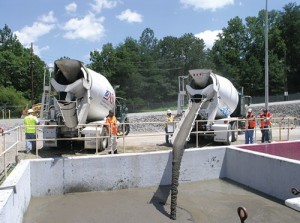
Workers fill the sumps at the Toxic Substances Control Act Incinerator with grout, as part of the work to close it. (Submitted photo)
A one-of-a-kind waste incinerator, which began operations at the East Tennessee Technology Park more than 20 years ago, has been safely shut down.
When the Toxic Substances Control Act Incinerator, or TSCAI, began operations in 1990, the intent was to run it for five years to prove the technology worked. It was the only incinerator in the nation permitted to burn certain hazardous and radioactive wastes.
Operations ceased in December 2009, after a safe and successful run that saw the facility burn 35 million pounds of liquids and solids from DOE sites across the United StatesÔÇöeven some from Hawaii.
Those waste streams now go to commercial contractors.
ÔÇťOther incinerators burned different types of waste, but this was the only one that did it all. It could do virtually anything,ÔÇŁ said chemical operator Brenda Carroll, a chemical operator for URS-CH2M Oak Ridge LLC, or UCOR, the U.S. Department of EnergyÔÇÖs cleanup contractor for its Oak Ridge Reservation. Carroll worked at TSCAI since it began operations.
The final boxes of waste from cleanup of the incinerator were shipped on Dec. 13, according to UCOR Project Manager Mary Magleby. The facility is now in what is called a safe shutdown mode and will be safely maintained until funding is available to demolish it.
Getting the facility to this point was a four-year process involving cooperation among the Tennessee Department of Environment and Conservation, the Environmental Protection Agency, DOE, and UCOR, Magleby said. Because the incinerator processed polychlorinated biphenyl (PCB) waste and hazardous waste regulated by federal laws, it had to meet strict closure standards. Closure activities included cleaning, rinsing, and decontamination of tanks, flooring, sumps, and other equipment and subsequent testing to verify that contamination had been removed to required specifications.
In a few areas where PCB contamination could not be reduced to certain levels, special fixative paints were applied to the surfaces to prevent any potential spread of contamination. Various controls, such as facility signs and inspections, were implemented. Soil and concrete sampling was performed around the facility to ensure the effectiveness of cleanup.
During operations, the incinerator was highly regulated and contained numerous environmental permits. EPA and TDEC have agreed to termination of the environmental permits associated with facility operations.
After closure actions on the RCRA-permitted waste units were completed, additional decontamination activities were completed on the wastewater treatment facilities associated with TSCAI so that the facility could be safely maintained until funding is available for demolition.
The process has been bittersweet for those who work at TSCAI.
ÔÇťEach step of this process brought some sadness,ÔÇŁ said Glenn Collett, also a TSCAI chemical operator. ÔÇťThis place deserves to be part of the history book and the history of Oak Ridge. Everyone here knew theyÔÇÖd been a part of something special. ItÔÇÖs something to tell our grandkids about.ÔÇŁ
In addition to deactivating and demolishing the K-25 Building and other facilities at ETTP, UCOR is responsible for other specific scopes of work at ETTP, the Y-12 National Security Complex, and the Oak Ridge National Laboratory.
Leave a Reply